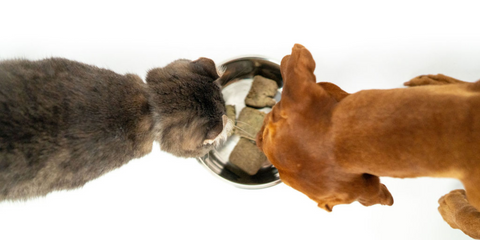
Dog & Cat Yeast Infection Diet: A Complete Nutritional Guide
By Dr. Keith Weingardt, DVM
Is your dog constantly battling yeast infections or itchy skin? Is your cat dealing with chronic ear issues or skin irritation that just won’t clear up? Learn how yeast issues in pets are often linked to diet and gut imbalance — not just what’s on the skin.
Yeast overgrowth in cats and dogs is one of the most common issues I see in my practice, and one of the most frustrating for pet parents. When your dog struggles with chronic itching, ear infections, or that unmistakable ‘yeasty’ smell, it often reflects an imbalance in the body’s microbiome.
The good news is nutrition can play a powerful role in bringing your pet’s system back into balance.
Here’s how I approach supporting pets with yeast imbalances in three key steps.

1. Build a Strong Foundation With the Microbiome
Solving your pet’s yeast problem starts with a diversified diet. Adding probiotics helps restore that balance and keeps yeast under control.
In most cases, yeast isn’t the primary problem — it’s a symptom of deeper imbalance. Think of your pet’s microbiome like a tiny city of good bacteria that keeps their body balanced. It takes a diverse village of beneficial microbes to regulate the immune system, support digestion, and keep opportunistic organisms in check. When this internal ecosystem gets out of balance, yeast can take over, causing itchy skin or ear issues.
That’s why restoring microbial diversity is one of the first steps I recommend. Some pets even benefit from a brief 24-hour fast from solid food to help reset the gut before transitioning to a fresh, whole-food, minimally processed diet. Adding whole-food probiotics like Leaf Probiotic and Wild Mushroom Probiotic can then help repopulate the gut with beneficial bacteria and improve immune resilience.
This balanced foundation not only reduces the likelihood of yeast returning but also supports overall vitality from the inside out.

2. Use Diet Energetics to Help the Body Heal
What and how you feed can make a real difference in how your pet’s body responds to yeast. Different foods carry different energetic properties: some are warming and drying, while others are cooling and moistening. Put simply, this is another way of describing how different foods influence the body’s internal balance.
If your pet tends to run cold and seeks warmth, incorporating more warming foods can help restore equilibrium and support the body’s natural defenses. Whole-food recipes and toppers featuring lamb, goat, or salmon, along with Vitality Blend and venison broth, are excellent choices. I’m especially fond of the freeze-dried Vitality Blend with Astragalus for its immune-supportive properties.
On the other hand, if your pet overheats easily, pants frequently, or shows signs of inflammation like persistent itching, cooling foods can help disperse internal heat and soothe irritation. Choose whole-food recipes, treats, toppers, and broths made with rabbit, duck, or pork, and add a scoop of Bailey’s Blend or Just Greens for additional cooling, detoxifying support.
Matching the food’s energetic qualities to your pet’s specific presentation is a simple but effective way to support healing and help bring their body back into balance.

3. Support the Liver for Detox and Recovery
As we rebalance the microbiome and improve nutrition, the liver becomes the primary filter for processing and eliminating metabolic waste. If this system is overburdened, those byproducts can linger and contribute to inflammation or recurring flare-ups.
Supporting liver function helps the body clear these toxins more efficiently and reduces the chance of yeast rebounding. I often recommend incorporating Bam’s Beets to stimulate healthy bile flow and detox pathways, and Bailey’s Blend with Cleavers to assist lymphatic drainage and circulation.Lua’s Golden Paste, rich in antioxidants and anti-inflammatory compounds, adds another layer of support by reducing oxidative stress on the liver itself.
Used together or in rotation, these whole-food formulas create a powerful support system for the liver and immune system alike, helping your pet stay balanced long-term.
When to Call in Support
Most pets show real improvement within four to six weeks of a fresh, whole-food diet, targeted probiotics, and liver support. But if yeast symptoms persist or keep returning, that’s a sign it’s time to call in professional help. An integrative veterinarian can assess deeper imbalances and may recommend additional herbal, nutritional, or therapeutic support to fully restore your pet’s health.
Finding Balance From the Inside Out
If you’re dealing with a yeasty dog or cat, don’t feel overwhelmed — yeast overgrowth can be stubborn, but with the right nutritional strategy, it’s absolutely manageable. By restoring microbial balance, choosing foods that match your pet’s needs, and supporting the liver’s detox pathways, you can help guide your dog or cat back to comfort, balance, and long-term health.




